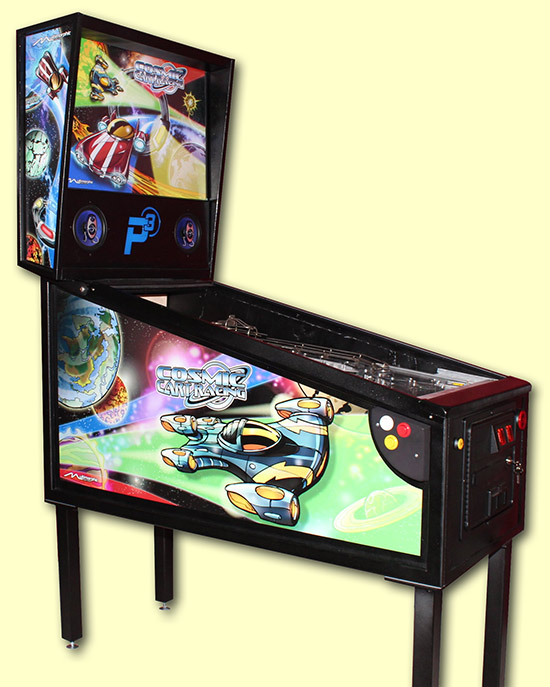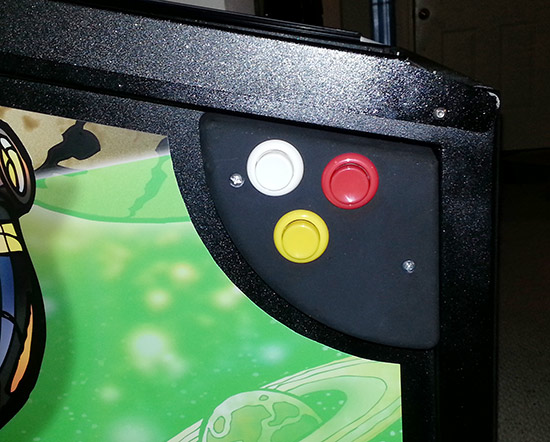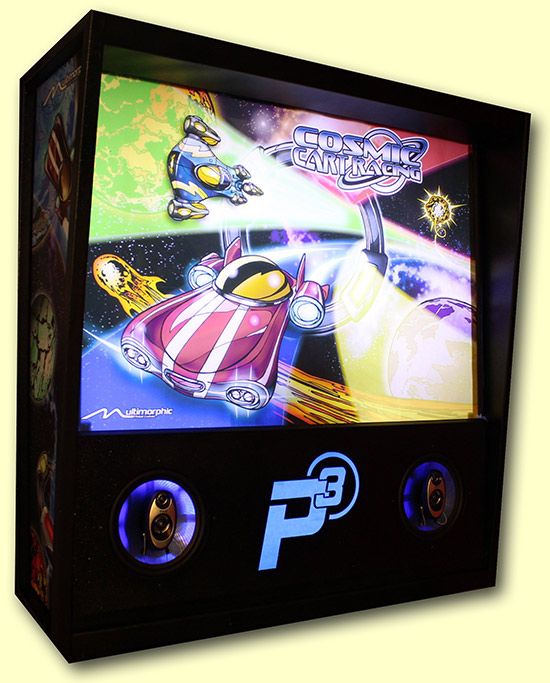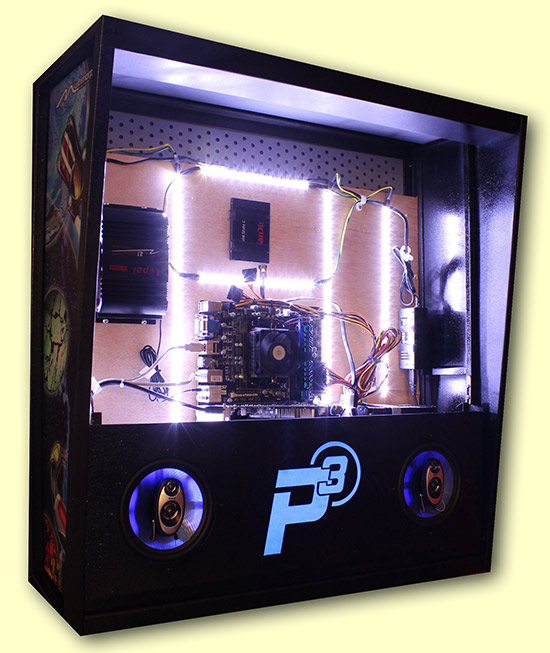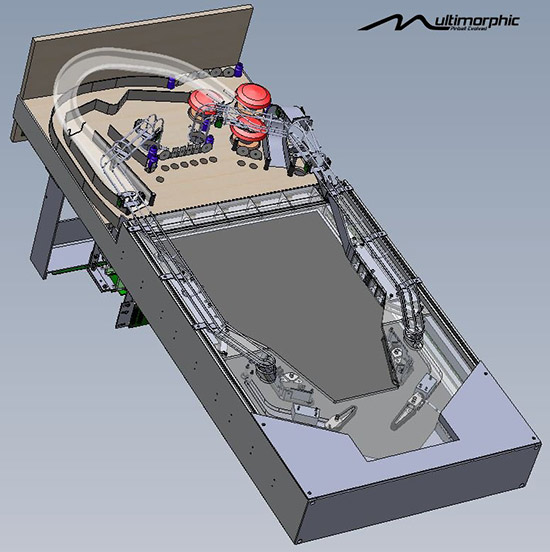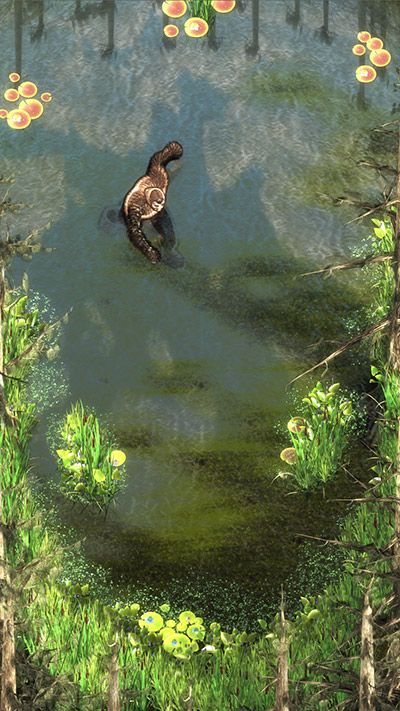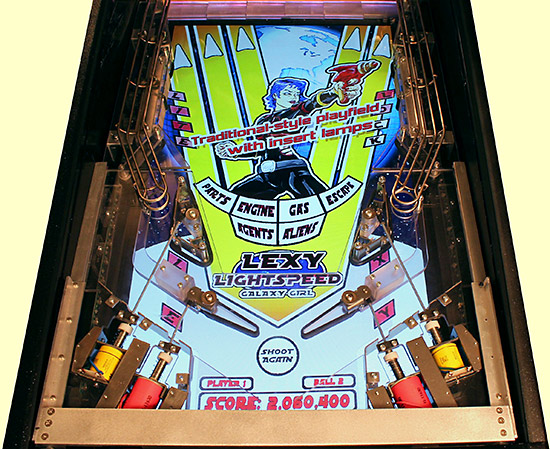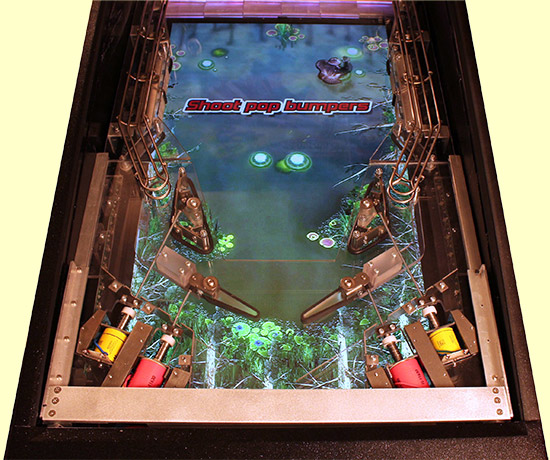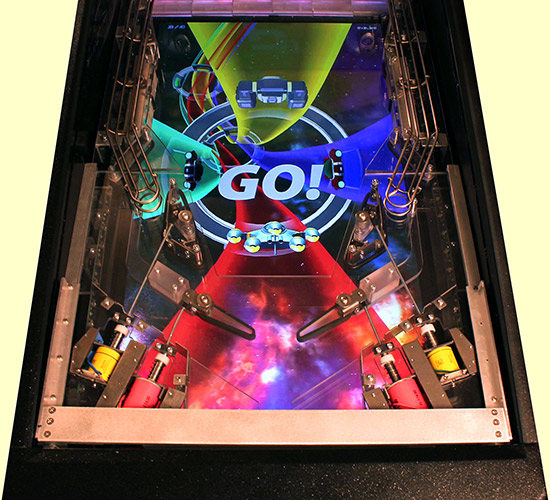P3 -
NEW
CABINET, |
| Date: 14th October, 2013 Our latest exclusive update on the P3 pinball platform brings you more details of the first two games: Lexy Lightspeed - Galaxy Girl and Cosmic Cart Racing, new cabinet and backbox designs, and an innovative new playfield mounting system. We also find out who is working at Multimorphic and take a look at the cabinet and translite artwork. With the latest P3 prototype about to be exhibited at Pinball Expo in Chicago, we can bring you a preview of the games visitors will see and play. So let's start with the first sight people will get of the game - those new cabinet and backbox designs. These have been completely re-engineered to give a more traditional look and feel, while incorporating a number of unique features.
For a start, both the cabinet and backbox are made from metal frames into which the side panels are slotted. This not only provides better protection for the artwork, but it also visually frames it to make it more tightly integrated into the game. The flipper buttons are also part of the modular system. They come in a swappable box which can be changed to provide additional controls for specific titles. If a game needs a miniature track ball, or multiple buttons to operate playfield features, these can be provided in a custom button box which is supplied with that title.
Although it appears as if it is a permanent fixture, the cabinet and backbox artwork is still easily removable whenever the game or playfield module is changed for a different title. But if the game is intended for public locations, additional trim is available to prevent unauthorised removal. The new backbox is laced with LED strips to provide bright and even illumination of the title's translite. The hinged backbox's more conventional design is to be offered as an alternative to the lower-profile speaker box which doesn't include a translite.
According to Multimorphic head, Gerry Stellenberg, the inclusion of a more familiar backbox design is a result of feedback received from previous showings. He told Pinball News, "Certainly a lot of potential customers want a traditional looking game, and it's always been our plan to offer both traditional backboxes and low profile speaker boxes. The backbox aesthetic is tried and true, whereas we're still thinking through the best way to present an aesthetically pleasing speaker box only solution. A full backbox has the added benefit of storage space." That space will be put to good use, housing the system's PC motherboard and associated devices such as solid-state drive and audio amplifier. The redesigned low-profile speaker box will also contain these same components.
Gerry explained the philosophy behind putting these key components in the backbox as opposed to installing everything in the cabinet. He told us, "Our control system is distributed throughout the machine, but we're using a fairly powerful computing engine to run our software, and the backbox is the perfect place for it. In fact it's really the only reasonable place for it. In my opinion, the computing engine should not be in the main cab, under the playfield. The ergonomics involved with servicing features on the cabinet floor are awful. I'm sure anybody with back issues will agree."
To work on the flipper mechanisms, slingshots or wireforms, you simply slide them out of the frame. The same for the target banks and the LCD monitor. Should you want to clean or replace the playfield, that slides out too. Gerry told us why they have opted for this method of construction. He explained, "Lots of reasons, the biggest being manufacturability, modularity, and serviceability. I believe pinball companies can and should be designing machines with customer needs at the forefront of their thoughts rather than as afterthoughts. If somebody wants to clean the playfield on their game, it shouldn't take hours or days to carefully disassemble everything, document the process, and carefully lay out things out in a specific order such that reassembly won't be a nightmare. They should just be able to remove what's dirty, clean it, and re-install it. That's a big part of our design philosophy - how can we accomplish each design goal in a way the makes our customers lives easier." This would help address concerns that using the same set of lower playfield features could lead to different games feeling very similar to play, and provide far more flexibility for third party game designers to realise their vision using the P3 as the platform. The Multimorphic team see the P3 as being akin to a computer games system like the X-Box/Playstation or a smartphone, where game developers don't need to worry about building the hardware or the underlying operating system, allowing them to concentrate on perfecting their game.
"Regarding, the playfield LCD, we're mixing traditional visual elements with new concepts. Part of the game is played with generally static playfield artwork, complete with 'insert lamps' that blink to indicate mode activity and active shots. At other times, we're making heavy use of dynamic graphics with the LCD.
Regarding interactions with the LCD, LL-GG doesn't have any purely virtual modes. Some modes are purely physical, requiring only physical shots to make progress, and other modes combine physical shots with virtual targets."
"CCR wanders a bit farther from the pinball-norm. It's a racing game; the objective is to win races. It doesn't make much sense to present a racing game as a traditional 3 or 5-ball game. Instead, there is no concept of ball number. When you launch the first ball, the race begins. If you lose 1, 2, 5, 10, etc. balls, you get penalized by having your cart slow down, stop, or crash, but the game doesn't simply end. Your game ends when the race is over and you didn't do well enough to proceed to the next race. How does this affect multi-player gaming? Multi-player games on a single machine are similar to racing heats. You play a race. Then other players play a race. Winners move on to the next 'heat'. Multi-player gaming on multiple machines (network connected) is simultaneous. That's how you can race directly against other human players. There are other differences though from other racing-themed pinball machines. It is cart-style racing after all... so expect power-ups and fun ways of improving your performance or slowing down your opponents."
"The CCR playfield was designed with a racetrack in mind. There are inner loops, outer loops, and ramps that all return the ball to the flipper (via the playfield, not via raised wireforms). It's intended to be fast-paced and require ball control skills to get deep into the game. Beginners should be able to enjoy winning a race every now and then, while experts should be able to get through a couple of races before they'll have to be 'in the zone' to keep winning. The use of the playfield LCD in CCR is completely different than in LL-GG. The CCR playfield will present the race. As such, the playfield will be fully dynamic, following your cart around the racetrack. We aren't using too many virtual interactions, but there are some." Here's a sample of the LCD playfield animations from both games. There is currently a total of 14 members of the Multimorphic team working on the two games and the P3's hardware. Apart from Gerry, there are two 3D modelers - Rory Cernuda and Russel Rega, two artists - Scott Gullicks (creator of the Wrath of Olympus game) and Matt Wessel, three mechanical engineers - Les Pitt, TJ Weaver and Trey Jones, as well as four software engineers, one sound engineer and a circuit board designer. "Unsurprisingly, a lot of developers and engineers loved the innovations and future plans for the machine. In fact, most of our development team volunteered after seeing one of the prototypes at a show. What surprised me, though, was how many people had no interest in the machine simply because of how raw it looked. In retrospect, it makes perfect sense, but I wasn't expecting it at the time. I just assumed everybody would see what it could be become rather than what it was. The good news is that hearing the negative feedback about the look of the machine motivated us to spend a lot of time working out the aesthetics, and our current prototype is a very close representation of our final plans."
© Pinball News 2013 |

